Czichos H., Saito T., Smith L.E. (Eds.) Handbook of Metrology and Testing
Подождите немного. Документ загружается.

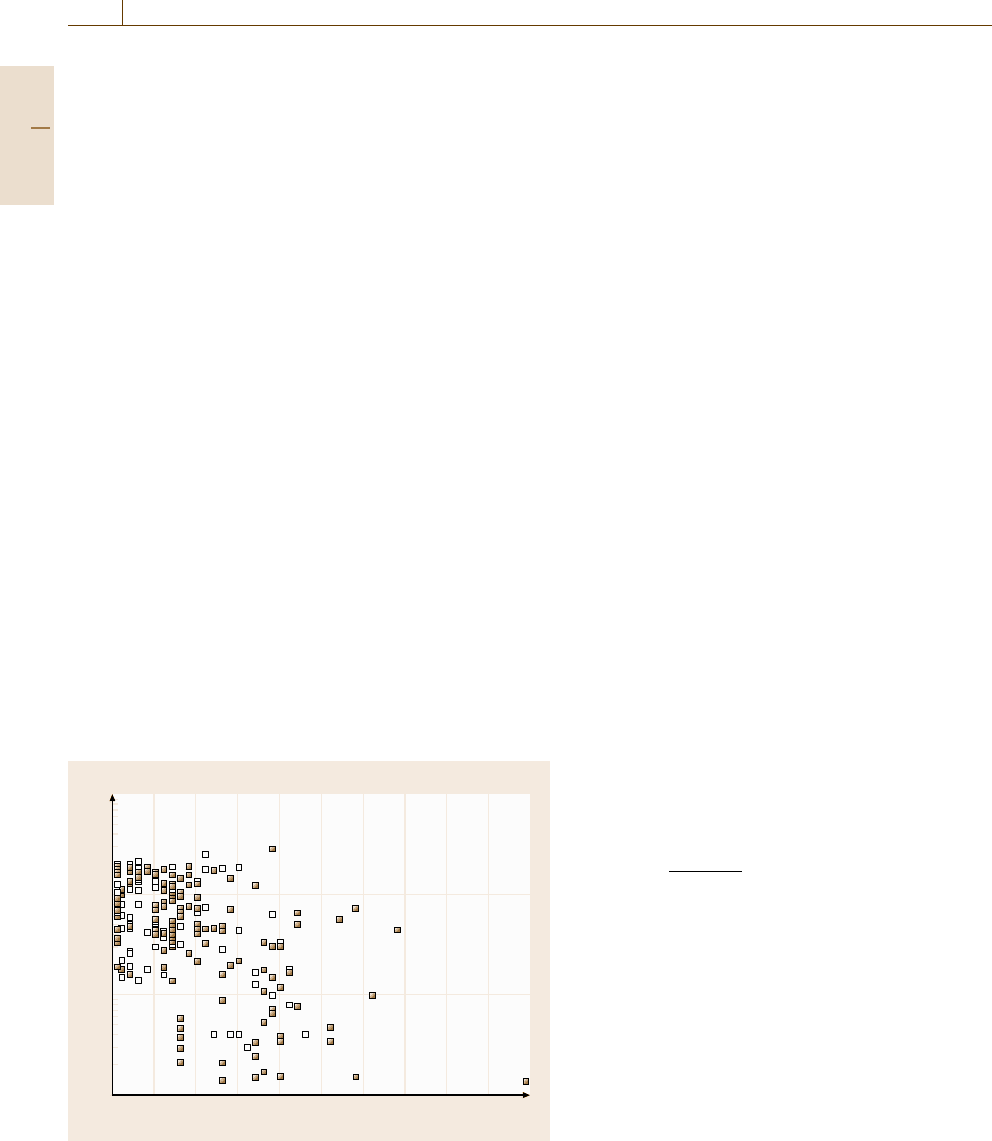
418 Part C Materials Properties Measurement
the temperature of fracture test, z is distance of the notch
opening gage location above the surface of the speci-
men and V
p
is the plastic component of critical notch
opening displacement, as defined by Fig. 7.89.
CTOD Testing of Welds
Fracture toughness evaluation of welds is more compli-
cated than that of base metal because the welds have
heterogeneities in terms of microstructure and tough-
ness. Therefore, toughness values of welds inherently
show large scatter. The existence of local brittle zones
(LBZ) in the heat-affected zone (HAZ) sometimes gives
extremely low toughness values. From this viewpoint,
special attention should be paid to CTOD testing for
welds.
Figure 7.90 shows the variation of critical CTOD
values of high-strength-steel weld HAZ as a fraction of
the coarse-grained (CG) HAZ along the fatigue precrack
front in the thickness direction [7.245]. This result indi-
cates that at least 15% of the CG HAZ should be sampled
by the fatigue precrack to assess the lower-bound CTOD
value; see below for the definition of %CG HAZ.Most
of the CTOD testing standards of weld HAZ specify
the %CG HAZ for this reason. Typical standards of for
CTOD testing method for welds are specified in [7.246,
247]. Among these, API RP 2Z [7.246] was the first to
specify a CTOD testing method for weld HAZ.Other
standards follow the same concept. The API RP 2Z stan-
dard is intended for preparing and certifying fabrication
welding procedures and assuring that the steel to be sup-
plied is inherently suitable for welding.
Critical CTOD (mm)
10
1
0 5 10 15 20 25 30 35 40 45 50
0.1
0.01
% CG regions
Fig. 7.90 Critical CTOD values versus % CG regions for steels
showing some LBZ behavior (after [7.245])
API RP 2Z refers to BSI 7448 part 1 [7.238]and
ASTM E 1290-02 [7.243]fortheCTOD testing method.
Additional requirements are specified regarding the
notch positioning in the weld and post-test examinations
for sampling the CG HAZ regions, which is thought
to have lower-bound toughness. Figure 7.91 shows the
HAZ regions in a multipass weld. Because of the multi-
thermal cycles induced by multipass welding, the HAZ
has an extremely complex microstructure distribution.
It is intended that the fatigue precrack certainly sam-
ples the CG HAZ. For this purpose, the fatigue precrack
should be carefully introduced. Welding should be made
carefully so that the fusion line of the weld is straight
enough to sample as much CG HAZ as possible. It
should be noted that proper welding consumables and
welding procedures should be adopted to maintain a cer-
tain level of critical CTOD value for the weld metal. In
addition, welding residual stress may be relieved prior to
fatigue precracking to promote crack-front straightness.
This is done by lateral compression (Fig. 7.92)[7.248].
API RP 2Z requires three levels of weld heat inputs.
At least five or eight, depending on the heat input, CTOD
tests should be conducted for each welding condition. At
least three specimens aim to sample the CG HAZ regions
close to the fusion line and at least two specimens aim to
sample the boundary region between the HAZ and base
metal.
Post-test metallographic examinations are specified.
Figure 7.93 shows the sectioning method for this pur-
pose. The broken half of the specimen is sectioned at the
fatigue precrack front, etched and its microstructure is
revealed. The CG HAZ regions sampled by the fatigue
precrack tip is measured (Fig. 7.94), and the %CG is cal-
culated as
%CG =
100
n
i
L
i
B
, (7.115)
where L
i
is length of the i-th CG region sampled by the
crack front and B is the plate thickness. The CG regions
need not be continuous. The value of %CG should be
at least 15% for the three specimens. For the other two
specimens, the crack front should sample at least 50%
of the boundary region between the HAZ and the base
metal.
The CTOD toughness values are influenced by many
other factors than the local brittle zones. One is the de-
gree of strength matching, i. e. the ratio of yield strength
of the weld metal to that of base metal. An overmatch
may cause excessive constraint in the HAZ,whichmay
cause unexpectedly low critical CTOD values.
Part C 7.5
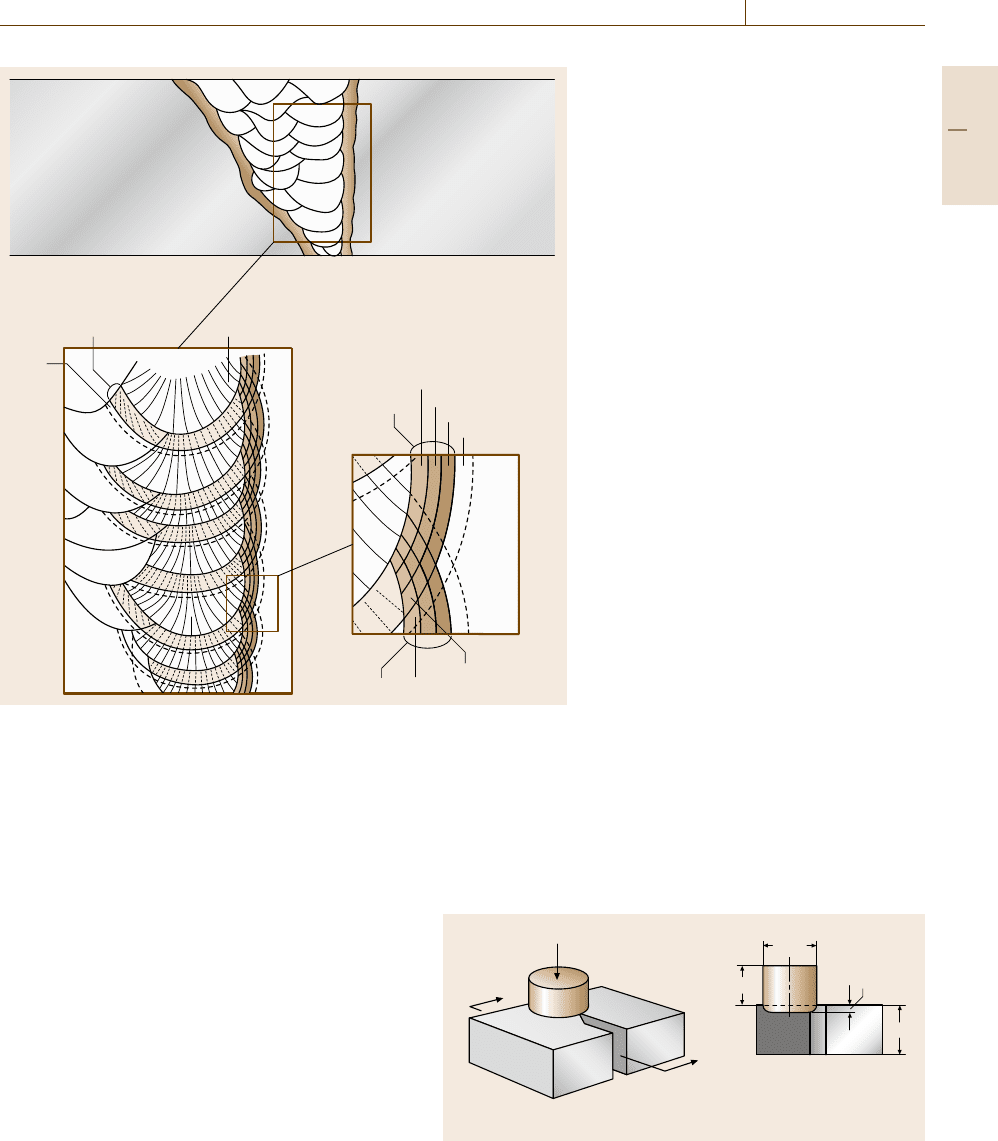
Mechanical Properties 7.5 Fracture Mechanics 419
Etched HAZ
in weld metal
(CG, FG and
ICHAZ)
SCHAZ
in weld
metal
Columnar weld metal
Etched HAZ
Unaltered FGHAZ
Unaltered CGHAZ
Unaltered ICHAZ
Unaltered SCHAZ
Etched HAZ SRCG
IRCG
Fig. 7.91 Schematic of microstruc-
tures in HAZ of a multi-pass welding
(after [7.246])
7.5.3 Fatigue Crack Propagation Rate
Fatigue crack propagation results from the cyclic plastic
strain cumulation at the crack tip, especially in sta-
ble crack propagation. It is expected that the crack
propagation rate da/dN can be related to the stress-
intensity factor range ΔK (= K
max
−K
min
). Since Paris
et al. [7.249, 250] first demonstrated the characteriza-
tion of crack growth by fatigue in the early 1960s,
a considerable number of works have covered the de-
termination of crack growth behaviors using fracture
mechanics. Figure 7.95 shows typical fatigue crack
growth behavior in metallic materials, which is ex-
pressed in a schematic log–log relationship between
da/dN and ΔK; ΔK is usually defined as the posi-
tive component of the total stress-intensity factor range,
which is
ΔK = K
max
−K
min
=(1 −R)K
max
for R ≥ 0
ΔK = K
max
for R ≤ 0 (7.116)
where R is the stress ratio (=σ
min
/σ
max
= K
min
/K
max
).
The sigmoidal curve in Fig. 7.95 can be divided into
three regions. Region I is a lower bound against crack
growth, which is characterized by a threshold value
ΔK
th
.BelowΔK
th
, there is no observable fatigue crack
growth. In region II, for intermediate ΔK values, the re-
A
A
P
B
B
B dia.
≤1% B
(or 0.5% B on each side)
P=1× 4 B
2
σ
Y
Section A–A
a)
b)
Fig. 7.92a,b Lateral compression prior to fatigue precracking, for
relieving welding residual stress (after [7.248])
Part C 7.5
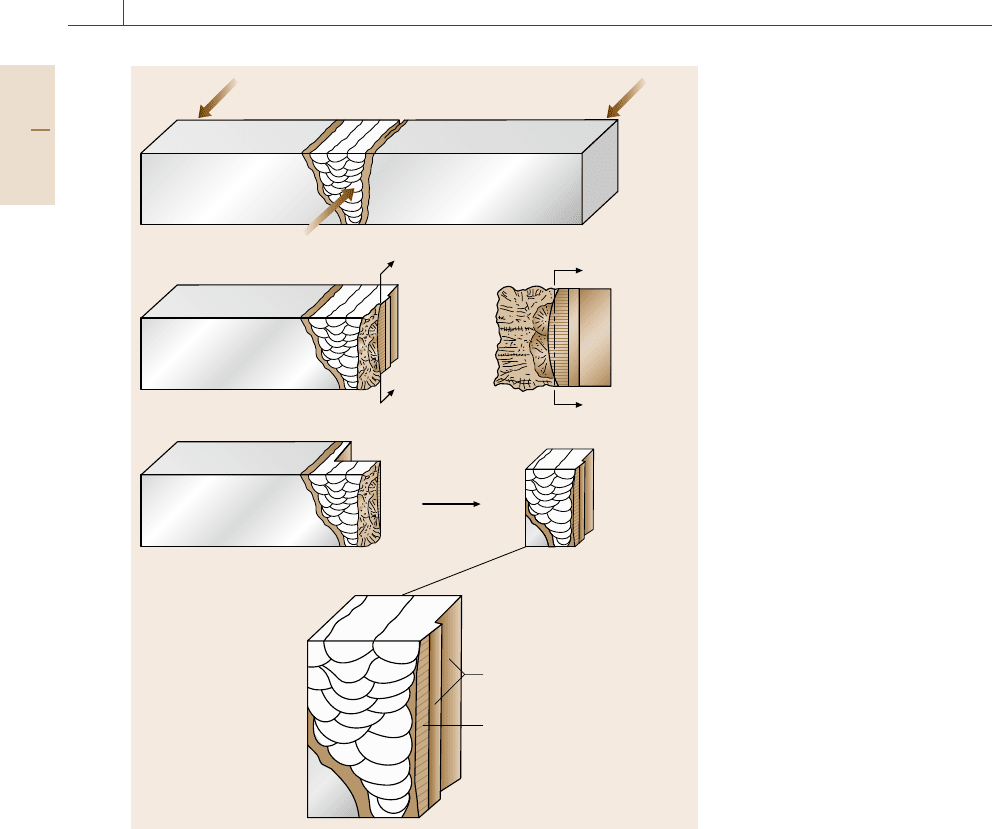
420 Part C Materials Properties Measurement
A
A
A
A
Fracture
face
Section A–A
Machined notches
Fatigue crack
Fig. 7.93 Sectioning the weld half of
a CTOD specimen for post-test metal-
lographic examination (after [7.246])
lationship in Fig. 7.95 can be fitted with a linear line,
which is formulated as
da/dN =C(ΔK)
m
, (7.117)
where C and m are both materials constants, which
should be determined experimentally. The fatigue crack
growth rate in region II is mainly controlled by ΔK,
and is insensitive to the R ratio. This power-law rela-
tionship for fatigue crack growth in region II was first
proposed by Paris and Erdogan [7.250]and(7.117)
is often referred to as Paris’ law. In region III, crack
growth is accelerated. Even if the applied stress am-
plitude Δσ is constant, ΔK shows a rapid increase
due to fast crack extension and the increased ΔK en-
hances the acceleration in crack growth. When the
K
max
[=ΔK/(1 −R)] reaches the fracture toughness
of the material K
c
, the crack growth transforms into
instability, which corresponds to an infinite value in
da/dN.
The ASTM has standardized the measurement
methodology for the fatigue crack propagation rate
based on fracture mechanics since 1978 [7.251]. The
following is a summary of the ASTM standard E 647.
The compact tension C(T) specimen with a side-edge
crack and the middle tension specimen M(T) with
a center crack are prescribed. The configurations of
the C(T) and M(T) specimens are shown in Figs. 7.96
and 7.97, respectively. The C(T) specimen is recom-
mended only for tension–tension loading while the
M(T) specimen can be loaded in either tension–tension
Part C 7.5
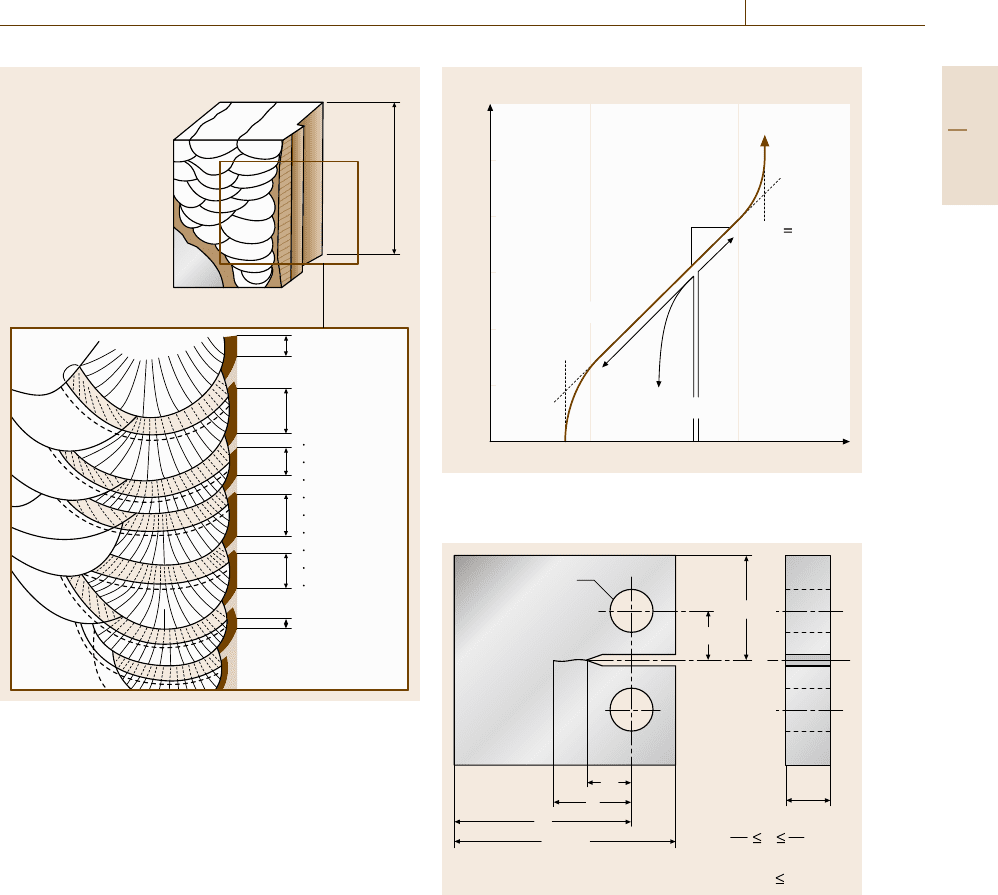
Mechanical Properties 7.5 Fracture Mechanics 421
Section A–A
B
L
1
L
2
L
n
Fig. 7.94 Calculation of %CG HAZ sampledbythefa-
tigue precrack tip (after [7.246])
or tension–compression. The configurations of both
specimens are given with proportional dimensions of
the specimen width W. The C(T) specimen prescribed
here has the same configuration as the C(T) spec-
imen in the toughness measurement except for the
specimen thickness B. It is not necessary to adopt
a large thickness in the fatigue crack growth, be-
cause the plane–strain concept is not required in the
da/dN measurement. Small specimen thicknesses are
rather better because a thumbnail crack front possi-
bly enhances the uncertainty in the measurement of
the crack length. From these points of view, the spec-
imen thickness requirement in a fatigue crack growth
measurement can be flexibly chosen within the recom-
mended range.
The formula for the stress-intensity factor K for each
type of specimen is given in the standard, being a func-
tion of the specimen dimensions and applied load P.It
is the ΔK that is calculated from the positive component
da/dN (m/cycle)
10
–4
10
–5
10
–6
10
–7
10
–8
10
–9
10
–10
Shedding ΔK
ΔK
th
ΔK
start
log ΔK
Quick dropped ΔK
Region IIIRegion IIRegion I
Paris low
da/dN = C (ΔK)
m
m
1
K
max
= K
c
Fig. 7.95 Schematic relation between stress intensity
range ΔK and crack growth rate da/dN
0.25 W Dia.
0.6 W
0.275 W
B
B
W
W
20
4
0.2 W
a
n
a
n
a
W
1.25 W
Fig. 7.96 Compact tension C(T) specimen
of an applied load amplitude ΔP (referring to (7.116))
and an extending crack length a (=a
o
+Δa).
A sharpened starter crack must be introduced by
fatigue from a machined notch. Sufficient size and
straightness of a fatigue crack must be kept to elim-
inate the effect of the machined starter notch on the
K calibration and the effect of the crack-front shape
on the subsequent crack growth rate data. The ma-
chined notch outline must lie within the 30
◦
angled
lines whose apex is at the end of the fatigue precrack
showninFig.7.98. The length of the precrack should
Part C 7.5
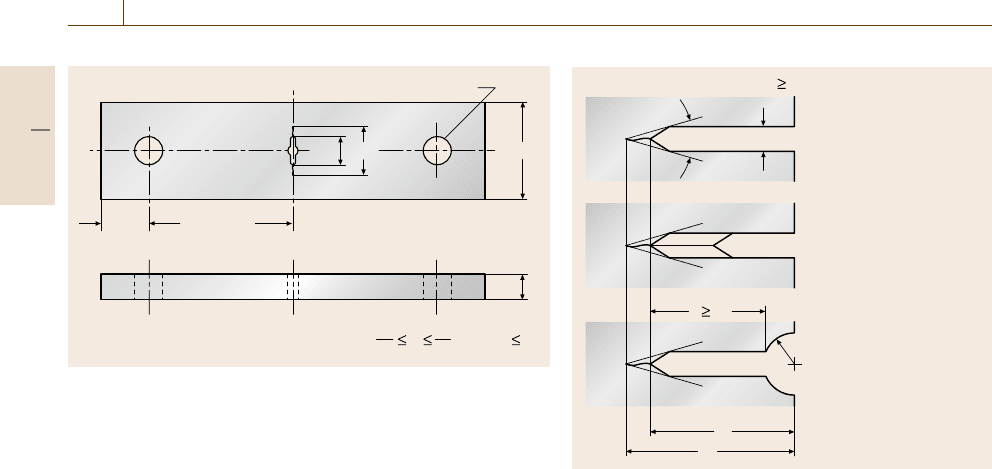
422 Part C Materials Properties Measurement
W/3 Dia.
W
W W
B
B
W/2
min.
1.5 W min.
2a
n
2a
8
4
0.2 W
a
n
Fig. 7.97 Middle tension M(T) specimen
not be less than 0.1B, h or 1 mm, whichever is greater.
The K
max
value during the fatigue loading for precrack-
ing must be suppressed below the initial K
max
value
for which the da/dN data are of interest. Precrack-
ing growth rates less than 10
−8
m/cycle are suggested,
especially when near-threshold growth rates are to be
obtained. The precrack sizes measured on the front and
back surfaces must not differ by more than 0.25B.
In da/dN measurements, the crack extension
should be measured as a function of elapsed cycles
under a controlled load amplitude. The crack can be
visually measured with a traveling microscope. The
compliance variation that is the crack opening displace-
ment response for a specified load and the electric
potential difference can be also used to estimate the
crack growth, similarly to the detection of the J
Ic
test methodology prescribed in ASTM E 1820 [7.237].
Bisual measurement is recommended, together with
either the compliance technique or the electric potential-
difference technique. In all methods, a minimum
resolution below 0.1mm or 0.002W (whichever is
greater) is required. Crack size extension is measured
at a Δa interval larger than 0.25 mm. However, the
Δa measurement in each crack extension of 0.25 mm
is sometimes difficult in near-threshold (ΔK
th
) testing,
where it is required that there are at least five da/dN
data points despite the fact that crack extension has al-
most stopped. In this case, the measuring interval Δa
can be reduced by ten times the crack size measurement
precision.
A loading procedure with either ΔK increasing or
ΔK decreasing must be selected, depending on the
da/dN value that is to be measured. The ΔK-increasing
procedure is well suited to fatigue crack growth rates
above 10
−8
m/cycle. However, it becomes gradually
h
h
W/16
Chevron
Straight through
Hole and slot for M(T) sp.
30°
r
l
2r
a
n
a
o
Fig. 7.98 Examples of fatigue precrack from machined
notch
more difficult for small initial da/dN values because
the applied ΔK should be smaller than that in the pre-
cracking.
The ΔK-decreasing test procedure can be con-
ducted for rates below 10
−8
m/cycle. In the ΔK-
increasing test procedure, an applied load range (ΔP)
and other loading variables (stress ratio and frequency)
are fixed constant. The schematic variation of the ΔK
value and the crack growth Δa as a function of elapsed
cycles are shown in Fig. 7.99a.
In the ΔK-decreasing test procedure for da/dN
measurements below 10
−8
m/cycle, ΔK and K
max
must start from a level equal to or greater than the ter-
minal precracking values. Subsequently, the load ΔP
is shed as the crack grows, until the lowest ΔK or
crack growth rate of interest is reached. Load shed-
ding is usually performed as decreasing load steps at
specified crack size intervals, as shown in Fig. 7.99b.
The shedding of load should be gradual enough to
preclude anomalous data resulting from sudden reduc-
tions in the stress-intensity range. The load reduction
in each shedding step should not exceed 10% of the
maximum load P
max
in the previous load step. Af-
ter a step reduction, a minimum crack extension of
0.5 mm is recommended. The da/dN measured us-
ing these shedding rules sometimes shows a trace
different from the true material properties, as shown
in Fig. 7.95. This mainly results from strain harden-
ing and compressive residual stress in the crack–tip
Part C 7.5
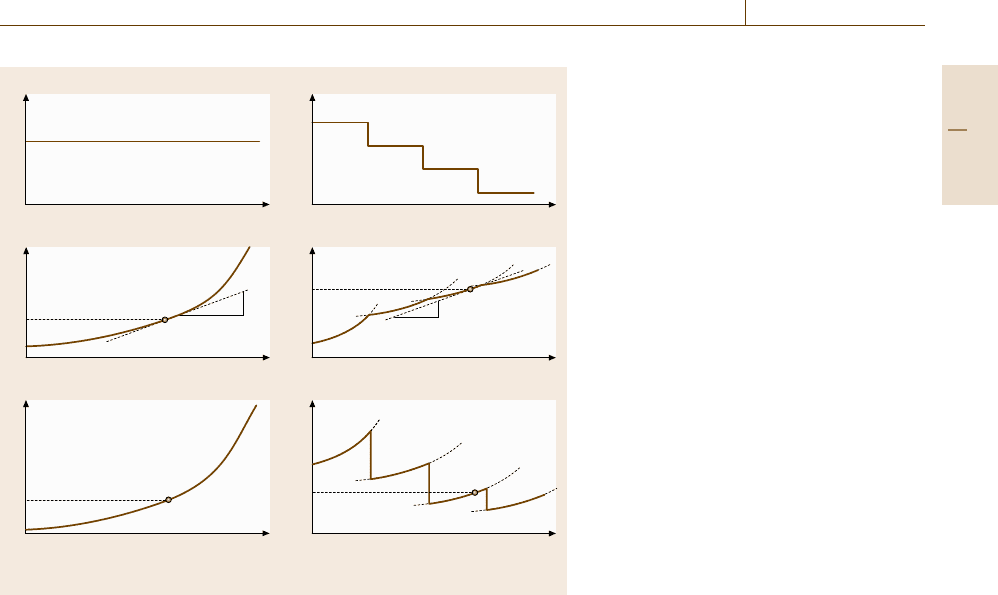
Mechanical Properties 7.5 Fracture Mechanics 423
Force range ΔP
Applied load range ΔP
Stress intensity factor range Δ K
Stress intensity factor range Δ K
Crack growth behavior
Crack growth behavior
Applied load range ΔP
ΔK(ΔP, a)
ΔK(ΔP, a)
Force range Δ P
Crack length a
Crack length a
Cycles N
Cycles N
Cycles N
Cycles N
Cycles N
Cycles N
dN
da
dN
da
a) b)
ΔK-increasing test ΔK-decreasing test
Fig. 7.99a,b Correspondences of ap-
plied load with crack growth and
stress-intensity factor range. (a) ΔK-
increasing test, (b) ΔK-decreasing
test
plastic zone formed in the previous load step. This
mis-measured da/dN–ΔK relation usually gives an
overestimation in the fatigue crack growth resistance of
the materials.
The crack growth rate is determined from the crack
size versus elapsed loading cycles data (a–N curve).
The secant and incremental polynomial methods are
recommended. Both methods are suitable for the ΔK-
increasing test. For the ΔK-decreasing tests, where load
is shed in decremented steps, the secant method is rec-
ommended. A crack growth rate determination should
not be made over any increment of crack extensions that
include a load step. The secant method simply involves
a calculation of the slope of the straight line joining two
adjacent data points on the a–N curve. It is formally
expressed as follows
(da/dN)
˜
a
=(a
i+1
−a
i
)/(N
i+1
−N
i
) . (7.118)
Since the da/dN value calculated in this way is an
average rate over the a
i+1
−a
i
increment, the average
crack size
˜
a =(a
i+1
−a
i
)/2 is used to calculate ΔK.
On the other hand, the incremental polynomial method
involves fitting a second-order polynomial to a set of
(2n +1) successive data points, where n is usually taken
to be 1–4. The form of the equation for the local fit is
as follows
ˆ
a
i
=b
0
+b
1
(N
i
−C
1
)/C
2
+b
2
(N
i
−C
1
)/C
2
2
,
(7.119)
where −1 ≤ (N
i
−C
1
)/C
2
≤+1andb
0
, b
1
,andb
2
are the regression parameters that are determined
by the least-square approximations over the range
a
i−n
≤a ≤a
i+n
. The value
ˆ
a
i
is the fitted value of the
crack size at N
i
. The parameters C
1
= (N
i−n
+N
i+n
)
and C
2
=(N
i−n
−N
i+n
) are used to scale the input data.
The crack growth rate da/dN at N
i
is calculated from
the derivative of the parabola above, as follows
(da/dN)
ˆ
ai
=b
1
/C
2
+2b
2
(N
i
−C
1
)/C
2
2
. (7.120)
The ΔK value associated with this da/dN value is
calculated using the fitted crack size
ˆ
a
i
corresponding
to N
i
.
Both recommended methods can give the same av-
erage da/dN response. However, the secant method
often results in increased scatter in da/dN relative to
the incremental polynomial method, since the latter nu-
merically smoothes the data.
The K
max
value of all data must be examined within
the linear elastic fracture mechanics. When the data
Part C 7.5
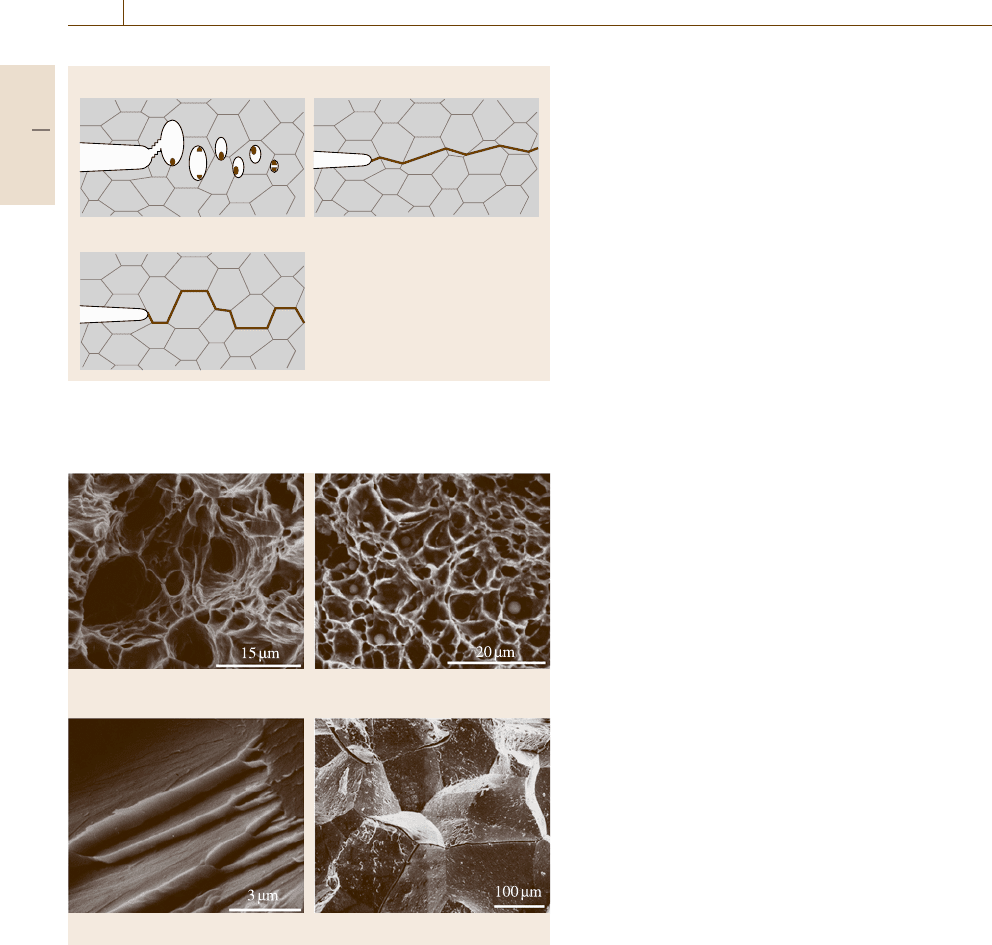
424 Part C Materials Properties Measurement
a)
c)
b)
Fig. 7.100a–c Three of the most common fracture mechanisms:
(a) microvoid coalescence fracture; (b) cleavage fracture; (c) inter-
granular fracture
a)
b)
c)
d)
Fig. 7.101a–d SEM micrographs for most common fracture ap-
pearances: (a) microvoid coalescence fracture/dimple pattern;
(b) microvoid coalescence fracture/dimple pattern; (c) cleavage
fracture/river pattern; (d) intergranular fracture
satisfy the specimen size requirements below, the spec-
imen can be predominantly identified as elastic.
W −a ≥(4/π)(K
max
/σ
Y
)
2
for a C(T) specimen,
W −2a ≥1.25P
max
/(Bσ
Y
) for an M(T) specimen.
(7.121)
This specimen size requirement here is rather more re-
laxed than that in the fracture toughness K
Ic
for unstable
fracture prescribed in ASTM E-399 [7.231].
The relation as shown in Fig. 7.95 appears on the
log–log graph plots between da/dN and valid ΔK.At
least five data points of approximately equal spacing at
growth rates 10
−9
–10
−10
m/cycle are needed to deter-
mine the threshold value of ΔK, denoted by ΔK
th
.
The best-fit straight line from a linear relation of
log da/dN versus log ΔK using a minimum of five
data points of approximately equal spacing at growth
rates of 10
−9
–10
−10
m/cycle. The ΔK
th
value is deter-
mined from the ΔK that corresponds to a growth rate of
10
−10
m/cycle on the fitted line.
The da/dN–ΔK relation and/or the ΔK
th
value,
which are measured with laboratory specimens, can be
applied to the crack growth assessment of the structures.
As ΔK is a function of both an applied stress range
and a crack length, an integration of the da/dN–ΔK
relation or (7.117) with an assumed initial crack size
predicts the crack growth for a elapsed loading cycles
in service. When the calculated ΔK for a stress range
in service and an initial crack size is smaller than the
ΔK
th
value, no crack growth is predicted.
However, it is necessary to examine the crack clo-
sure effect in testing. Compressive residual stress and/or
crack deflection often suppress crack–tip opening in
spite of the applied tensile load. The effective stress-
intensity factor range for a crack–tip opening of ΔK
eff
is smaller than the apparent value, which enhances the
overestimation in the ΔK
th
value of the material. The
da/dN–ΔK
eff
relation is sometimes evaluated using the
compliance variation procedure or the high-stress-ratio
loading.
The effect of small cracks in practical applications
should also be considered. When an initial crack in
a structure is smaller than a certain crack size, the crack
sometimes behaves differently from Fig. 7.95.Evenfor
smaller values of ΔK than ΔK
th
, small cracks can
grow. da/dN for a small crack is generally faster than
the value of da/dN estimated using the long-crack
method, even for the same ΔK. This small-crack effect
may result from both the effect of discontinuities in the
microstructure and limitations of fracture mechanics.
7.5.4 Fractography
Important information can be obtained from micro-
scopic examination of the fractured surface. This study
is usually called fractography. The scanning electron
microscope (SEM) is commonly employed in fractog-
Part C 7.5
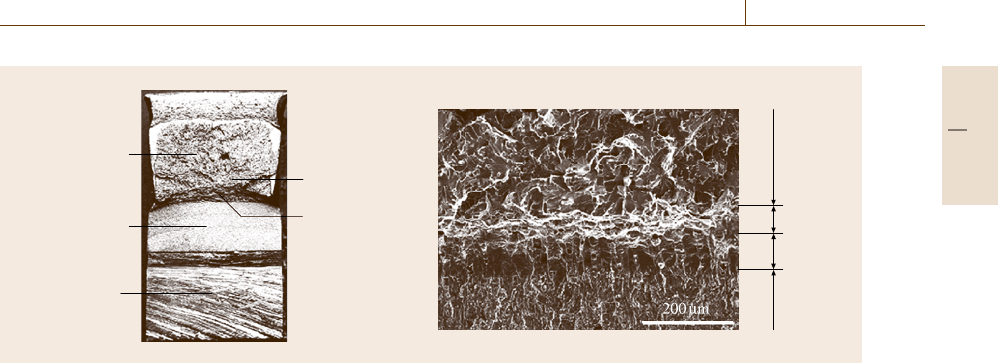
Mechanical Properties 7.5 Fracture Mechanics 425
Cleavage fracture
Fatigue precrack
Machined notch
Fatigue
precrack
SZW
Microvoid
Cleavage
Cleavage trigger
Ductile crack
(microvoid)
a) b)
Fig. 7.102a,b Fracture appearance of toughness specimen in low carbon steel: (a) macroscopic observation, and (b) mi-
croscopic observation
raphy because of its large depth of focus. Fractography
is sometimes applied in order to find the cause of acci-
dental failures.
Figure 7.100 shows schematically three of the most
common fracture mechanisms, which are caused by
monotonic tension in metallic engineering materials.
Ductile materials usually show microvoid coales-
cence type of fracture, shown in Fig. 7.100a. Microvoids
nucleate at second-phase particles or inclusions due to
either interface decohesion or particle cracking. Af-
ter growth of the voids, adjacent voids coalesce due
to ligament fracture. The appearance of the fracture is
characterized by the dimples showninFig.7.101a. In
material with many inclusions, the dimple size on the
fracture surface is small because they coalesce easily
(Fig. 7.101b).
The BCC and hexagonal close-packed (HCP) crys-
talline systems have cleavage planes along specific
crystallographic planes. Once cleavage fracture is trig-
gered, a crack along a cleavage plane propagates
unstably. The propagating crack changes its direc-
tion each time it crosses a grain boundary, as shown
in Fig. 7.100b. Figure 7.101c shows the appearance of
the fracture, observed by an SEM. The fracture surface
consists of several flat facets. The facet edges converge
to a single line like tributaries of a river. When a prop-
agating cleavage crack encounters a grain boundary,
the nearest cleavage-plane angle in the adjacent grain
is often oriented at a twist angle to the current cleav-
age plane. Cracking in a number of parallel cleavage
planes just beyond a grain boundary accommodates the
twisted-angle mismatch. This river pattern is caused by
the convergence of multiple cracks into a single crack
during its propagation within a grain.
Under special circumstances, cracks can propa-
gate along grain boundaries, as shown in Fig. 7.100c.
This intergranular fracture sometimes appears when the
strength of the grain boundary is weakened by the
following mechanisms: segregation of embrittling ele-
ments or precipitation of a brittle phase on the grain
boundary, grain-boundary cavitation at elevated temper-
ature, or attack of the grain boundary by corrosion or
hydrogen. The grain boundary, which looks like rock
candy, is shown under SEM observation in Fig. 7.101d.
The macroscopic appearance of fractures such as the
ductile and brittle types described do not necessarily
correspond to the microscopic fracture. In low-carbon
steels, however, ductile fracture is generally caused by
microvoid coalescence, and cleavage fracture leads to
brittle fracture with less ductility.
In fracture toughness tests for low-carbon steels,
cleavage fracture is often triggered after a certain crack
extension due to microvoid coalescence. Figure 7.102a
shows the macroscopic appearance of a fracture tough-
ness specimen obtained at the ductile–brittle transition
temperature. The dark thumbnail area following the
fatigue precrack shows stable crack extension due to
microvoid coalescence. A triggered cleavage crack at
the ductile crack tip propagates unstably. Figure 7.102b
shows the fracture appearance transition observed by
SEM. The stretched zone (SZ) can be observed between
the fatigue precrack and the ductile crack. The SZ is
not caused by fracture, but by a blunting deformation of
the fatigue precrack. The stretched zone (SZ) conceptu-
ally corresponds to the crack–tip opening displacement
CTOD. The fracture toughness of material can be esti-
mated from the depth and/or the width of the stretched
zone on the fracture surface.
Part C 7.5
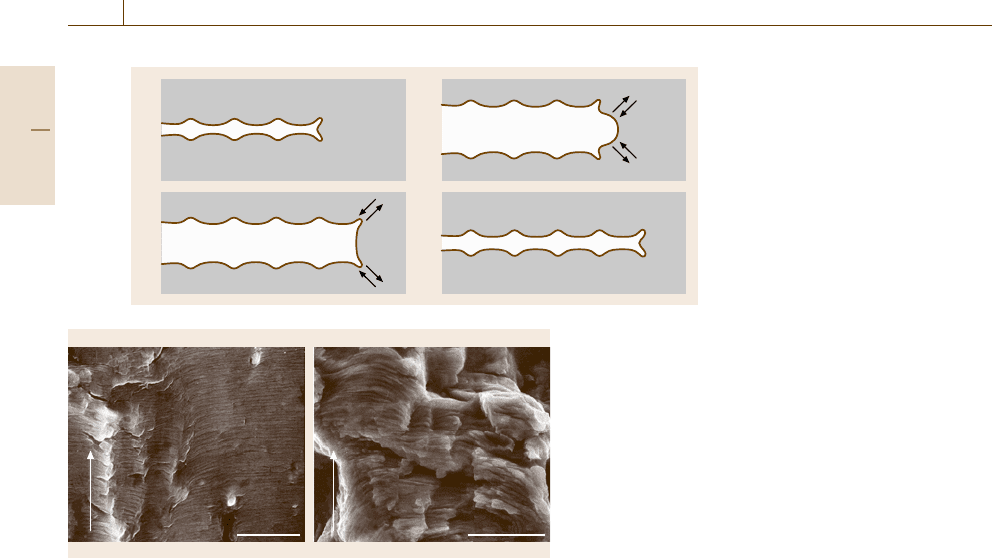
426 Part C Materials Properties Measurement
a)
c)
d)
b)
Fig. 7.103a–d Plastic blunting
process for striation formation (af-
ter [7.252])
Propagation
Propagation
3 μm
3 μm
a) b)
Fig. 7.104a,b Fatigue striations in: (a) aluminum alloy, and (b) steel
Fatigue crack propagation often produces striations
on the fractured surface. Figure 7.103 shows one of the
proposed mechanisms for striation formation [7.252].
When the tensile stress is applied, the crack tip
is blunted due to the concentrated slip deformation
(Fig. 7.103b). The fatigue crack incrementally extends
as a result of the formation of this stretched zone. When
the stress changes to compression, the slip direction
at the crack tip is reversed (Fig. 7.103c). This process
causes the buckling to form a resharpened crack tip. The
ripples left by these process above can be observed as
striations.
Figure 7.104 shows typical striations for aluminum
alloy and steel. Striations are formed in a similar
manner in materials with plasticity. According to the
mechanism in Fig. 7.103, the striation spacing is equal
to the crack growth rate da/dN.
7.6 Permeation and Diffusion
The diffusion of small molecules in materials has at-
tracted significant interest, primarily because it is of
great significance to many applications in the chem-
ical, petrochemical and medical industries [7.253,254].
For example, a polymer matrix has the ability to ex-
hibit different permeation rates for various chemical
species, thus providing the basis for separation [7.253].
Current applications include water desalination, gas
and vapor purification, and medical applications such
as controlled-release devices and the artificial kid-
ney [7.253, 254]. Separations using membranes have
inherent advantages over conventional separation tech-
nologies, including low energy cost (since no phase
transition is involved in the separation), high reliabil-
ity (no moving parts) and small footprint [7.255]. Of
particular interest are gas separations, where polymeric
membranes behave as molecular filters. For example,
an O
2
/N
2
selectivity of 5.9 can be achieved in poly-
meric membranes such as polysulfone, even though the
kinetic diameter difference between O
2
and N
2
is only
0.018 nm [7.256]. Additionally, if a polymeric material
is not very permeable to penetrants such as O
2
and H
2
O,
it acts as a barrier, which can be useful for packaging
applications [7.257].
This section reviews experimental techniques used
to study gas and vapor sorption, diffusion and per-
meation in polymeric films. The more detailed fun-
damental theory and industrial applications pertinent
to gas transport in polymers are available in several
books [7.258–261] and review articles [7.262–264].
Specific reviews of experimental methods to measure
gas transport properties are also available [7.265–268].
In particular, Felder and Huvard reviewed experimen-
tal methods from a historical perspective and critically
evaluated the strengths and weaknesses of the various
techniques in 1980 [7.265]. Without intending to re-
view the subjective exhaustively, the main objective
of this section is to provide readers with a self-
Part C 7.6
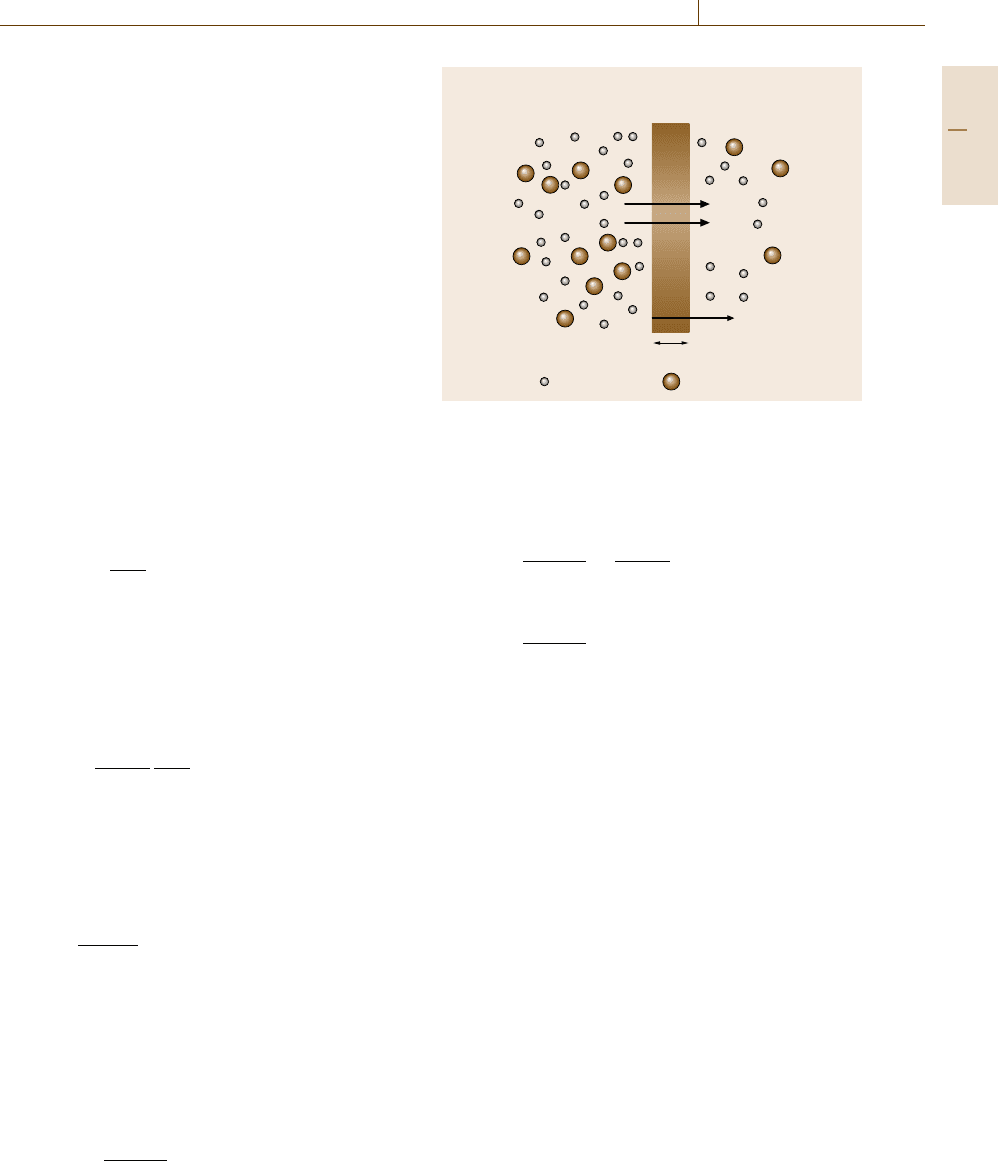
Mechanical Properties 7.6 Permeation and Diffusion 427
consistent set of manual-like instructions to choose and
design the most suitable and reliable experimental tech-
niques for specific systems based on our laboratory’s
experience.
7.6.1 Gas Transport:
Steady-State Permeation
Gas transport through a dense or nonporous polymeric
film is often described by the solution–diffusion mech-
anism [7.269]. As illustrated in Fig. 7.105, feed gas at
a high (i. e., upstream) pressure p
2
dissolves into the
feed-side surface of the film, diffuses through the film
due to a concentration gradient, and finally desorbs from
the permeate-side surface at the downstream (i. e., low
pressure) face of the film. In the absence of chemical
reaction between the gas and polymer, the diffusion of
dissolved penetrant is the rate-limiting step in this pro-
cess. The one-dimensional flux of gas A through the
film in the x-direction (i. e., N
A
) can be described by
Fick’s Law [7.264,270]
N
A
=−D
dC
A
dx
+w
A
(N
A
+N
p
) , (7.122)
where D is the gas diffusion coefficient in the film, C
A
is the local concentration of dissolved gas and w
A
is
the weight fraction of gas A in the film; N
p
is the flux
of the membrane, which is typically taken to be zero.
Consequently, (7.122) reduces to [7.264]
N
A
=−
D
1 −w
A
dC
A
dx
(7.123)
Steady-State Permeation
The steady-state permeability of gas A, P
A
, through
a film of thickness l is defined as [7.262,264,271]
P
A
≡
N
A
l
p
2
− p
1
, (7.124)
where p
2
and p
1
are the upstream (i. e., high) and down-
stream (i. e., low) pressures, respectively. Permeability
coefficients are commonly expressed in Barrers, where
1 Barrer =1×10
−10
cm
3
(STP)cm/cm
2
scmHg.Com-
bining (7.123)and(7.124) and integrating from x = 0
(C = C
2
)tox =l (C = C
1
), one obtains
P
A
= D
A
C
2
−C
1
p
2
− p
1
, (7.125)
Component A Component B
N
B
N
A
x
l
Upstream
p
2
Downstream
p
1
>
Fig. 7.105 Transport of gases A and B across a membrane
where D
A
is the concentration-averaged effective diffu-
sion coefficient in the range C
1
–C
2
D
A
=
1
C
2
−C
1
C
2
C
1
D
1 −w
A
dC
=
1
C
2
−C
1
C
2
C
1
D
eff
dC , (7.126)
where D
eff
is the local effective diffusion coefficient.
In general, it can be challenging to measure the av-
erage gas diffusivity directly. Instead, gas permeability
and gas solubility are often measured independently,
and gas diffusivity is inferred from these measure-
ments, as described below. For simplicity, experiments
are often designed so that p
1
p
2
and, consequently,
C
1
C
2
. In this limit, (7.125) reduces to
P
A
= D
A
× S
A
, (7.127)
where S
A
=C
2
/p
2
is the apparent sorption coefficient
or solubility of penetrant A in the polymer. There-
fore, by measuring the gas permeability at an upstream
pressure of p
2
and solubility at a pressure of p
2
, one
can calculate the average gas diffusivity D
A
. As indi-
cated in (7.126), this diffusion coefficient is an average
over the concentration range 0–C
2
. The local effective
diffusion coefficient D
eff
, characterizing the penetrant
diffusivity in the polymer at a penetrant concentration of
C
2
, can be evaluated using an equation obtained by tak-
ing the derivative of both sides of (7.125) with respect
Part C 7.6
